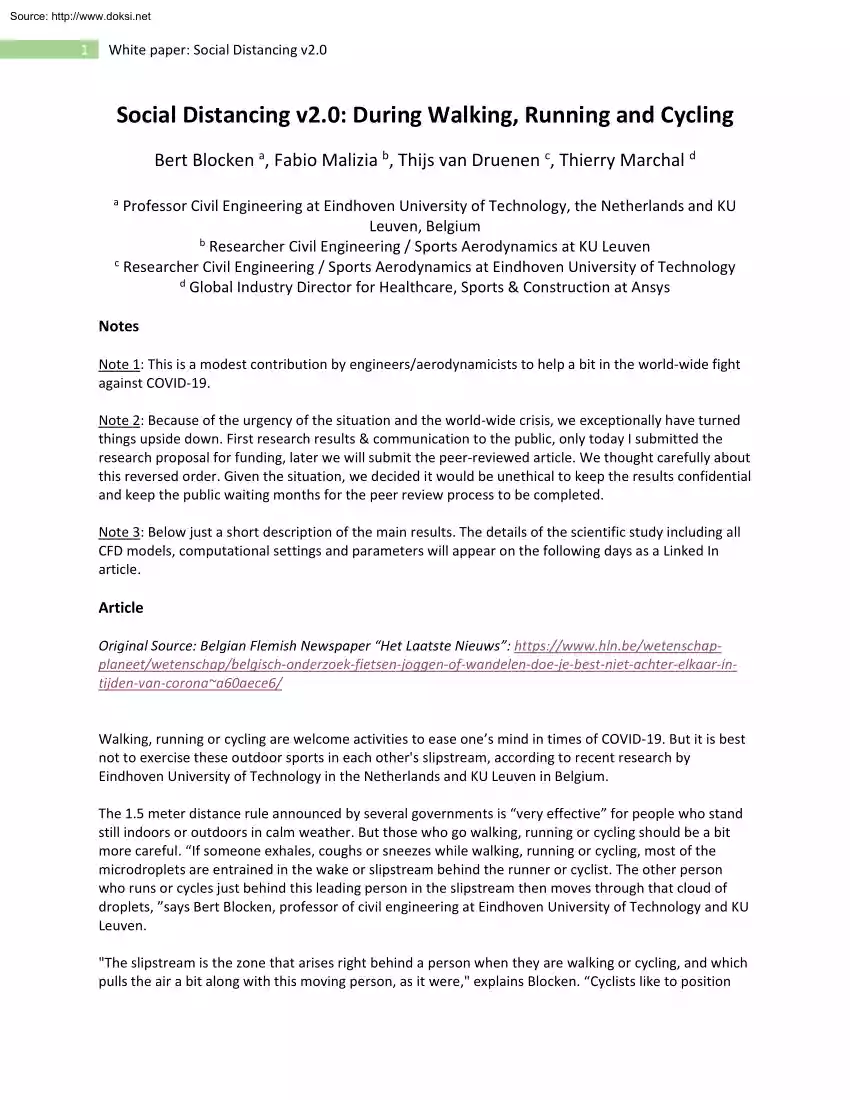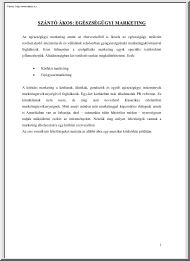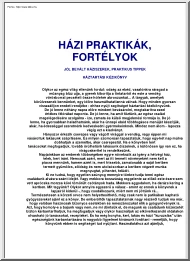Datasheet
Year, pagecount:2020, 3 page(s)
Language:English
Downloads:3
Uploaded:May 25, 2020
Size:735 KB
Institution:
-
Comments:
Eindhoven University of Technology
Attachment:-
Download in PDF:Please log in!
Comments
No comments yet. You can be the first!Content extract
Source: http://www.doksinet 1 White paper: Social Distancing v2.0 Social Distancing v2.0: During Walking, Running and Cycling Bert Blocken a, Fabio Malizia b, Thijs van Druenen c, Thierry Marchal d a Professor Civil Engineering at Eindhoven University of Technology, the Netherlands and KU Leuven, Belgium b Researcher Civil Engineering / Sports Aerodynamics at KU Leuven c Researcher Civil Engineering / Sports Aerodynamics at Eindhoven University of Technology d Global Industry Director for Healthcare, Sports & Construction at Ansys Notes Note 1: This is a modest contribution by engineers/aerodynamicists to help a bit in the world‐wide fight against COVID‐19. Note 2: Because of the urgency of the situation and the world‐wide crisis, we exceptionally have turned things upside down. First research results & communication to the public, only today I submitted the research proposal for funding, later we will submit the peer‐reviewed article. We thought carefully about
this reversed order. Given the situation, we decided it would be unethical to keep the results confidential and keep the public waiting months for the peer review process to be completed. Note 3: Below just a short description of the main results. The details of the scientific study including all CFD models, computational settings and parameters will appear on the following days as a Linked In article. Article Original Source: Belgian Flemish Newspaper “Het Laatste Nieuws”: https://www.hlnbe/wetenschap‐ planeet/wetenschap/belgisch‐onderzoek‐fietsen‐joggen‐of‐wandelen‐doe‐je‐best‐niet‐achter‐elkaar‐in‐ tijden‐van‐corona~a60aece6/ Walking, running or cycling are welcome activities to ease one’s mind in times of COVID‐19. But it is best not to exercise these outdoor sports in each others slipstream, according to recent research by Eindhoven University of Technology in the Netherlands and KU Leuven in Belgium. The 1.5 meter distance rule announced
by several governments is “very effective” for people who stand still indoors or outdoors in calm weather. But those who go walking, running or cycling should be a bit more careful. “If someone exhales, coughs or sneezes while walking, running or cycling, most of the microdroplets are entrained in the wake or slipstream behind the runner or cyclist. The other person who runs or cycles just behind this leading person in the slipstream then moves through that cloud of droplets, ”says Bert Blocken, professor of civil engineering at Eindhoven University of Technology and KU Leuven. "The slipstream is the zone that arises right behind a person when they are walking or cycling, and which pulls the air a bit along with this moving person, as it were," explains Blocken. “Cyclists like to position Source: http://www.doksinet White paper: Social Distancing v2.0 2 themselves in the slipstream of others to reduce their air resistance. But someone who walks or runs also has
such a slipstream. We have seen that no matter how that zone forms, droplets end up in that air stream. So its best to avoid that slipstream”, says Blocken TU Eindhoven and KU Leuven CFD simulation of the slipstream with microdroplets for walking at 4 km/h. Snapshot at given moment in time. The researchers came to their findings by simulating the release of saliva particles from persons in motion (walking and running) and in different configurations (two people side by side, diagonally behind and right behind each other). Normally these simulation models are used by the research team to improve the performance level of elite athletes, both runners and cyclists, because it is very effective for athletes to stay in the wake of leading runners and cyclists. With regard to COVID‐19 infection risk, it is actually recommended to do the opposite, as it now turns out: to stay out of that slipstream. The researchers displayed the results of their research in a series of animations and
figures. The cloud of drops left behind by a moving person is clearly visible. "People who sneeze or cough spread the droplets with greater thrust, but also those who only exhale emit droplets." The red dots on the images represent the largest particles. These are generally considered to be the most contagious – although virology research should confirm this for COVID‐19 – and fall down faster. "But when someone walks through that droplet cloud1, they can still end up on that persons body", explains the scientist. 1 An important issue – currently the subject of intensive debates between scientists world‐wide – is to what extent the residue of micro‐droplets with the virus, after evaporation, still carries an infection risk. Further virology research should shed more light on this issue. Source: http://www.doksinet 3 White paper: Social Distancing v2.0 TU Eindhoven and KU Leuven CFD simulation of the slipstream with microdroplets for running
(fast) at 14.4 km/h Snapshot at given moment in time The simulations show that social distancing plays less of a role for two people who walk or run side by side in calm weather. The drops then end up behind the duo Those who move in a staggered arrangement are also less likely to catch saliva droplets from the predecessor, at least when there is no substantial cross‐wind. The risk of contamination is greatest when people walk or run closely behind each other and therefore in each others slipstream. Based on the results, Blocken advises to keep a distance of at least four to five meters behind the leading person while walking in the slipstream, ten meters when running or cycling slowly and at least twenty meters when cycling fast. "If you want to overtake someone, it is also recommended to start "pre‐ sorting" into a staggered arrangement from a fairly long distance – twenty meters with bicycles, for example, so that you can overtake carefully and at a proper
distance by moving in a straight line." Compare it to driving: if you want to overtake, you should also not wait until the very last moment. Concluding note: the CFD simulations were performed with Ansys Fluent CFD, based on foregoing intensive validation studies for gas and particle releases at different speed around full‐scale manikins representing human bodies. These validation studies will be reported in the peer‐reviewed scientific publication to appear later. ‐‐‐ END OF DOCUMENT ‐‐‐
this reversed order. Given the situation, we decided it would be unethical to keep the results confidential and keep the public waiting months for the peer review process to be completed. Note 3: Below just a short description of the main results. The details of the scientific study including all CFD models, computational settings and parameters will appear on the following days as a Linked In article. Article Original Source: Belgian Flemish Newspaper “Het Laatste Nieuws”: https://www.hlnbe/wetenschap‐ planeet/wetenschap/belgisch‐onderzoek‐fietsen‐joggen‐of‐wandelen‐doe‐je‐best‐niet‐achter‐elkaar‐in‐ tijden‐van‐corona~a60aece6/ Walking, running or cycling are welcome activities to ease one’s mind in times of COVID‐19. But it is best not to exercise these outdoor sports in each others slipstream, according to recent research by Eindhoven University of Technology in the Netherlands and KU Leuven in Belgium. The 1.5 meter distance rule announced
by several governments is “very effective” for people who stand still indoors or outdoors in calm weather. But those who go walking, running or cycling should be a bit more careful. “If someone exhales, coughs or sneezes while walking, running or cycling, most of the microdroplets are entrained in the wake or slipstream behind the runner or cyclist. The other person who runs or cycles just behind this leading person in the slipstream then moves through that cloud of droplets, ”says Bert Blocken, professor of civil engineering at Eindhoven University of Technology and KU Leuven. "The slipstream is the zone that arises right behind a person when they are walking or cycling, and which pulls the air a bit along with this moving person, as it were," explains Blocken. “Cyclists like to position Source: http://www.doksinet White paper: Social Distancing v2.0 2 themselves in the slipstream of others to reduce their air resistance. But someone who walks or runs also has
such a slipstream. We have seen that no matter how that zone forms, droplets end up in that air stream. So its best to avoid that slipstream”, says Blocken TU Eindhoven and KU Leuven CFD simulation of the slipstream with microdroplets for walking at 4 km/h. Snapshot at given moment in time. The researchers came to their findings by simulating the release of saliva particles from persons in motion (walking and running) and in different configurations (two people side by side, diagonally behind and right behind each other). Normally these simulation models are used by the research team to improve the performance level of elite athletes, both runners and cyclists, because it is very effective for athletes to stay in the wake of leading runners and cyclists. With regard to COVID‐19 infection risk, it is actually recommended to do the opposite, as it now turns out: to stay out of that slipstream. The researchers displayed the results of their research in a series of animations and
figures. The cloud of drops left behind by a moving person is clearly visible. "People who sneeze or cough spread the droplets with greater thrust, but also those who only exhale emit droplets." The red dots on the images represent the largest particles. These are generally considered to be the most contagious – although virology research should confirm this for COVID‐19 – and fall down faster. "But when someone walks through that droplet cloud1, they can still end up on that persons body", explains the scientist. 1 An important issue – currently the subject of intensive debates between scientists world‐wide – is to what extent the residue of micro‐droplets with the virus, after evaporation, still carries an infection risk. Further virology research should shed more light on this issue. Source: http://www.doksinet 3 White paper: Social Distancing v2.0 TU Eindhoven and KU Leuven CFD simulation of the slipstream with microdroplets for running
(fast) at 14.4 km/h Snapshot at given moment in time The simulations show that social distancing plays less of a role for two people who walk or run side by side in calm weather. The drops then end up behind the duo Those who move in a staggered arrangement are also less likely to catch saliva droplets from the predecessor, at least when there is no substantial cross‐wind. The risk of contamination is greatest when people walk or run closely behind each other and therefore in each others slipstream. Based on the results, Blocken advises to keep a distance of at least four to five meters behind the leading person while walking in the slipstream, ten meters when running or cycling slowly and at least twenty meters when cycling fast. "If you want to overtake someone, it is also recommended to start "pre‐ sorting" into a staggered arrangement from a fairly long distance – twenty meters with bicycles, for example, so that you can overtake carefully and at a proper
distance by moving in a straight line." Compare it to driving: if you want to overtake, you should also not wait until the very last moment. Concluding note: the CFD simulations were performed with Ansys Fluent CFD, based on foregoing intensive validation studies for gas and particle releases at different speed around full‐scale manikins representing human bodies. These validation studies will be reported in the peer‐reviewed scientific publication to appear later. ‐‐‐ END OF DOCUMENT ‐‐‐





